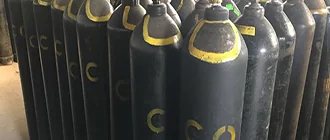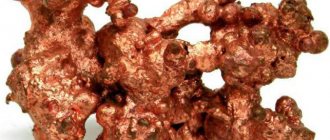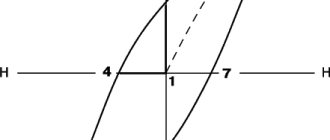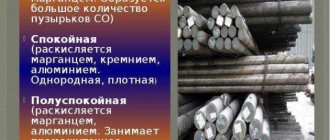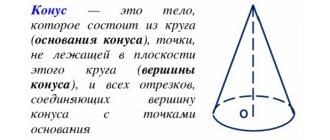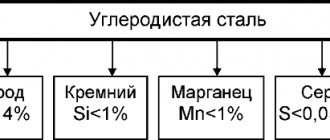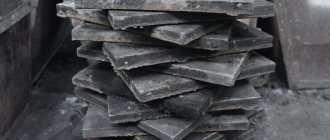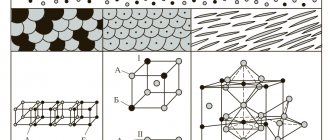Being in nature
In nature, carbon is found both in pure form and in the form of compounds. In the free crystalline state it is found in the form of two allotropic modifications:
- Diamond is an extremely hard substance that is a poor conductor of heat and electricity. In appearance, they are colorless crystals that strongly refract light. If they are cut accordingly, they will be diamonds; their weight is measured in carats: 1 carat = 0.205 g. The largest stones are given names: for example, Cullinan (more than 3 thousand carats), Star of Yakutia (232 carats), and others. Dull diamonds (bort) are used in industry. When heated without access to air, diamond turns into graphite. Currently, artificial diamonds are created from graphite (long-term heating at t=3000°C and a pressure of 70-100 thousand atmospheres). Synthetic products are widely used in technology.
- Graphite - forms powerful deposits. In appearance it is a gray-black mass that is greasy to the touch. It has a layered structure. Conducts heat and electricity well, refractory. Used in industry in the production of electrodes and pencil leads.
There is another modification - amorphous carbon. It is a porous black substance. Its “known representatives” are coke, soot, charcoal and bone charcoal. It is not found in its pure form and always contains impurities.
In a bound state, carbon is found in carbonates (calcite, limestone, chalk, marble, iron spar FeCO3, manganese spar MnCO3, zinc spar ZnCO3, magnesite, dolomite, malachite, and others). In addition, carbon is the main component of coal and other coals, oil, combustible natural gases, and all living organisms.
Practical application of carbides
As we have already discussed, covalent carbides have the widest range of practical applications. These include abrasive and cutting materials, and composite materials used in various fields (for example, as one of the materials included in body armor), and auto parts, and electronic devices, and heating elements, and nuclear energy. And this is not a complete list of applications of these super-hard carbides.
Salt-forming carbides have the narrowest application. Their reaction with water is used as a laboratory method for producing hydrocarbons. We have already discussed how this happens above.
Along with covalent carbides, metal-like carbides are widely used in industry. As we have already said, the metal-like type of compounds we are discussing are steels, cast irons and other metal compounds interspersed with carbon. As a rule, the metal found in such substances belongs to the class of d-metals. That is why it tends to form not covalent bonds, but, as it were, to be embedded in the structure of the metal.
In our opinion, the above compounds have more than enough practical applications. Now let's take a look at the process of obtaining them.
Basic properties
Carbon is inert towards all common solvents. The exception is some molten metals. However, after cooling it again crystallizes into graphite.
Under normal conditions, only black carbon is more chemically active. It can combine with fluorine, and with increasing temperature - with hydrogen, silicon, sulfur, boron and some other metals. As a result of the reaction, carbides are formed:
- 4Al + 3C → Al4C3.
- Ca + 2C → CaC2.
When carbides react with water or acid, methane or acetylene is formed:
- Al4C3 + 12HCl → 4AlCl3 + 3CH4 (methane).
- CaC2 + 2H2O → C2H2 (acetylene) + Ca (OH)2 (calcium hydroxide).
A number of carbides have a composition that does not obey the “generally accepted” idea of valence. These include, for example, Fe3C.
Carbon does not combine with nitrogen, but in the presence of hydrogen it forms hydrogen cyanide (substance formula HCN). In reactions with oxygen, it forms monoxide and dioxide, which releases a large amount of heat:
- C + O2 → CO2.
- Monoxide is most often released when dioxide is passed over hot coal: CO2 + C → 2CO.
Carbon is one of the most powerful reducing agents known in chemistry. When interacting with metal oxides, it “takes away” oxygen from them, thereby restoring the substances to a free state:
- ZnO + C → Zn + CO.
- SiO2 +2C → Si + 2CO.
When excess carbon interacts with silicon dioxide (quartz, sand), in addition to pure Si, carborundum (silicon oxide) is formed - a very hard substance: SiO2 + 3C → SiC + 2CO.
“Pure” carbon does not interact with halogens. Compounds with them are formed from other substances (for example, hydrocarbons).
Application
The elements are used to give cast iron and various types of steel hardness and increase their wear resistance. Tungsten and titanium carbides, as the hardest and most refractory options, are used for the manufacture of cutting tools, as well as for the production of superhard materials. Due to their good chemical and physical properties, the substances are used as a component of refractory materials, resistance rods of electric heating devices and as an abrasive material.
Calcium carbide is also called welding carbide. This is an ideal substance for welding: upon contact with water, it releases acetylene, a volatile gas that is the basis for oxygen welding, metallization, cutting and soldering.
There are many different chemical compounds known in the world: about hundreds of millions. And all of them, like people, are individual. It is impossible to find two substances that have the same chemical and physical properties with different compositions.
One of the most interesting inorganic substances existing in the world are carbides. In this article we will discuss their structure, physical and chemical properties, applications and analyze the intricacies of their production. But first, a little about the history of the discovery.
Carbon compounds
At the beginning of the 19th century, substances were divided into inorganic and organic. The second group includes hydrocarbons (methane, ethylene and acetylene series), proteins, carbohydrates, fats. Organic chemistry studies these substances.
Inorganic chemistry studies other carbon compounds: halides, cyanides, carbides, oxides. The most significant are oxygen-containing substances - CO, CO2. There is also C2O (dicarbon monoxide) and C3O2 (suboxide), but these are not yet well-studied substances.
Monoxide or carbon monoxide
Carbon monoxide 2 (another name for monoxide) - is formed during incomplete combustion of C or products containing it. Its main properties:
- It liquefies at a temperature of - 192 °C.
- Hardens at t=-205°C.
- Molecular weight - 28.01 g/mol.
- The structure of the molecule is linear (within the framework of the theory of valence bonds it can be written as “:C==O:”).
- It is practically insoluble in water.
Monoxide is a poisonous gas that is colorless and odorless. Its toxic effect is that it irreversibly interacts with hemoglobin in the blood, as a result of which the ability to transfer oxygen from the lungs to the tissues is completely lost.
In industry, monoxide is produced during the gasification process of solid fuel. In the laboratory, the compound can be synthesized by reacting concentrated sulfuric acid with oxalic acid (C2H2O4) or formic acid (HCOOH). The reaction occurs when heated:
- HCOOH → CO + H2O.
- C2H2O4 → CO + CO2 + H2O.
According to its chemical properties, divalent oxide is a good reducing agent. It burns well, releasing a large amount of heat: 2CO + O2 → 2CO2. Other characteristic features:
- The ability to “remove” oxygen from its compounds with metals: FeO + CO → Fe + CO2.
- In the presence of activated carbon, which acts as a catalyst, carbon monoxide with an oxidation state of +2 is capable of adding chlorine (Cl), thereby forming phosgene (COCL2), a chemical warfare agent. It is a colorless, highly toxic gas with the smell of rotten hay. The reaction equation for the production is: CO + Cl2 → COCl2.
- At high temperatures (above 400°C) and elevated pressure (300 atm) it reacts with hydrogen. As a result of the process, methyl alcohol (methanol) is formed: CO + 2H2 → CH3OH.
- At elevated temperatures, it reacts with alkalis, forming salts of formic acid (HCOOH): CO + NaOH → HCOONa.
- When interacting with ammonia, hydrocyanic acid is formed - a very toxic substance: CO + NH3 → HCN + H2O.
Carbon monoxide has wide practical applications. It is part of artificial gaseous fuel. In addition, it is indispensable in organic synthesis processes.
Carbon dioxide or CO2
It is a colorless gas with a weak sour odor and taste. The molar mass is 44.01 g/mol.
Note: carbon monoxide 4 is one and a half times heavier than air, so it can be “poured” from test tube to test tube.
Carbon dioxide (another name for carbon dioxide) does not support combustion. In addition, it makes breathing impossible: in a room where the concentration of the substance is high, a person will suffocate. What properties are inherent in the connection:
- Some substances that form a stronger bond with oxygen than carbon (for example, magnesium) can burn in carbon dioxide: 2Mg + CO2 → 2MgO + C.
- Combustion reaction with hot coal: CO2 + C → 2CO.
- Interaction with water: CO2 + H2O → H2CO3 (carbonic acid).
- Forms acidic oxides when interacting with basic oxides: Na2O + CO2 → Na2CO3 (sodium carbonate).
- With a lack of alkali, it forms hydrocarbonates: CO2 + NaOH → NaHCO3.
In industry, carbon dioxide is synthesized by thermal decomposition of limestone or chalk (sometimes dolomite, magnesite): CaCO3 → CaO + CO2. This substance can also be isolated from coke oven gas when burning coal, peat, oil products, and wood. In addition, it is also found in natural sources: for example, it “appears” as a result of volcanic activity, during the decay of organic substances.
In laboratory conditions, it is obtained by the interaction of CaCO3 and hydrochloric acid: CaCO3 + 2HCl → CaCL2 + CO2 + H2O (the reaction is carried out in a Kipp apparatus). Another way is to calcinate sodium bicarbonate: NaHCO3 → Na2CO3 + CO2 + H2O.
Carbon dioxide is of industrial importance: it is necessary in soda production, in the food industry (production of carbonated drinks), and for the synthesis of organic acids. Dry ice (solid dioxide) is used as a refrigerant - the carbon dioxide environment prevents food from decomposing. In addition, CO2 is also used in medicine (carbon dioxide baths to activate metabolic functions). It is also indispensable for agriculture - carbon monoxide IV is involved in photosynthesis, so its deficiency negatively affects plants.
What types of carbides are there?
It turns out that carbide, the formula of which is, say, CaC 2, differs significantly in structure from SiC. And the difference is primarily in the nature of the connection between atoms. In the first case, we are dealing with salt-like carbide. This class of compounds is named so because it actually behaves like a salt, that is, it is capable of dissociating into ions. This ionic bond is very weak, which makes it easy to carry out many other transformations involving interactions between ions.
Another, probably more industrially important type of carbides are covalent carbides: such as, for example, SiC or WC. They are characterized by high density and strength. They are also refractory and inert to diluted chemicals.
There are also metal-like carbides. They can rather be considered as alloys of metals with carbon. Among these we can highlight, for example, cementite (iron carbide, the formula of which varies, but on average it is something like this: Fe 3 C) or cast iron. They have a chemical activity intermediate in degree between ionic and covalent carbides.
Each of these subtypes of the class of chemical compounds we are discussing has its own practical application. We will talk about how and where each of them is used in the next section.
